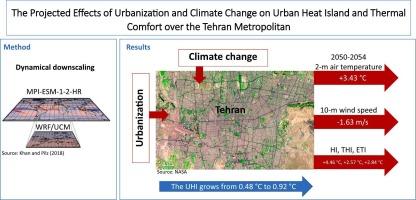城市化和气候变化对德黑兰都市热岛和热舒适的预估影响
IF 8
1区 环境科学与生态学
Q1 ENVIRONMENTAL SCIENCES
引用次数: 0
摘要
快速城市化和土地利用格局的变化加剧了特大城市面临的全球环境挑战。随着城市面临城市化和气候变化的双重压力,了解它们对热环境和城市弹性的单独和综合影响仍然是一个关键的研究重点。本研究采用天气研究与预报(WRF)模型和单层城市冠层模型(UCM),研究了7月份城市化和气候变化对德黑兰的局部影响,重点研究了SSP1-2.6、SSP2-4.5和SSP5-8.5情景下的当前(2019-2023)和中期(2050-2054)。结果表明,在所有选择的情景中,城市化和气候变化相互作用加剧了变暖并降低了风速。在SSP5-8.5情景下,到2050-2054年,德黑兰城区升温3.43±0.48°C,其中0.46±0.31°C归因于城市化,2.93±0.43°C归因于气候变化。在城市地区,风速下降- 1.63±0.19 m/s(84.66%),主要是由于气候变化,导致城市通风减少。然而,未来城市化将使10米风速每天增加0.09±0.02米/秒,白天增加0.20±0.02米/秒。使用HI、THI和ETI指数评估热舒适变化,结果表明,全球变暖主要导致热舒适增加4.46±0.28°C、2.57±0.25°C和2.84±0.27°C(73 - 87%)。本研究还评估了冷屋顶在缓解未来城市化和气候变化的不利小气候影响方面的有效性。结果表明,虽然冷屋顶有助于减缓城市化和气候变化对气温上升和热舒适的影响,分别高达4.37%和15%,但它也加剧了8.58%的风速下降,阻碍了污染物的扩散。这项研究表明,有必要将城市化和气候变化影响纳入可持续城市规划,为有针对性的适应和缓解战略提供有价值的见解。本文章由计算机程序翻译,如有差异,请以英文原文为准。

The projected effects of urbanization and climate change on urban Heat Island and thermal comfort over the Tehran metropolitan
Rapid urbanization and changes in land-use patterns have intensified global environmental challenges in megacities. As cities confront the dual pressures of urbanization and climate change, understanding their individual and combined impacts on the thermal environment and urban resilience remains a critical research priority. This study employs the Weather Research and Forecasting (WRF) model coupled with the single-layer Urban Canopy Model (UCM) to investigate the localized effects of urbanization and climate change on Tehran during July, focusing on the present (2019–2023) and mid-term future (2050–2054) under SSP1–2.6, SSP2–4.5, and SSP5–8.5 scenarios. The results reveal that urbanization and climate change interact to exacerbate warming and reduce wind speeds in all selected scenarios. Tehran's urban area warms by 3.43 ± 0.48 °C until 2050–2054 under the SSP5–8.5 scenario, with 0.46 ± 0.31 °C attributed to urbanization, and 2.93 ± 0.43 °C to climate change. In urban areas, wind speed decreases by −1.63 ± 0.19 m/s, primarily due to climate change (84.66 %), reducing urban ventilation. Future urbanization, however, increases 10-m wind speed by 0.09 ± 0.02 m/s daily and 0.20 ± 0.02 m/s during daytime. Thermal comfort variations are assessed using HI, THI, and ETI indices, which show increases of 4.46 ± 0.28 °C, 2.57 ± 0.25 °C, and 2.84 ± 0.27 °C, driven mainly by global warming (73–87 %). This study also evaluates the effectiveness of cool roofs in mitigating adverse microclimatic impacts of future urbanization and climate change. The results reveal that although cool roof helps mitigate the effects of urbanization and climate change on temperature rise and thermal comfort by up to 4.37 % and 15 %, respectively, it also exacerbates the reduction in wind speed by 8.58 %, hindering pollutant dispersion. This study shows the need to integrate urbanization and climate change impacts into sustainable urban planning, offering valuable insights for targeted adaptation and mitigation strategies.
求助全文
通过发布文献求助,成功后即可免费获取论文全文。
去求助
来源期刊

Science of the Total Environment
环境科学-环境科学
CiteScore
17.60
自引率
10.20%
发文量
8726
审稿时长
2.4 months
期刊介绍:
The Science of the Total Environment is an international journal dedicated to scientific research on the environment and its interaction with humanity. It covers a wide range of disciplines and seeks to publish innovative, hypothesis-driven, and impactful research that explores the entire environment, including the atmosphere, lithosphere, hydrosphere, biosphere, and anthroposphere.
The journal's updated Aims & Scope emphasizes the importance of interdisciplinary environmental research with broad impact. Priority is given to studies that advance fundamental understanding and explore the interconnectedness of multiple environmental spheres. Field studies are preferred, while laboratory experiments must demonstrate significant methodological advancements or mechanistic insights with direct relevance to the environment.
 求助内容:
求助内容: 应助结果提醒方式:
应助结果提醒方式:


